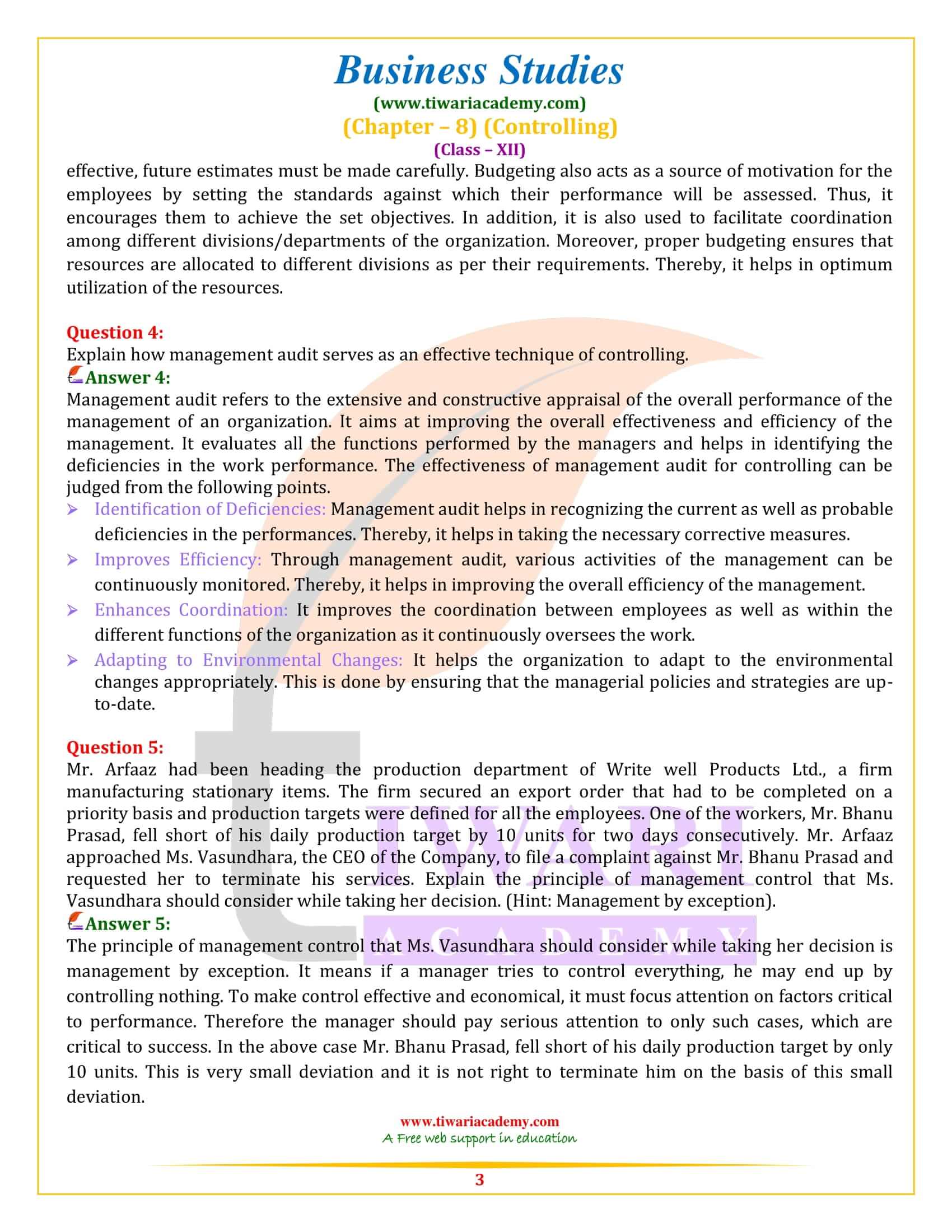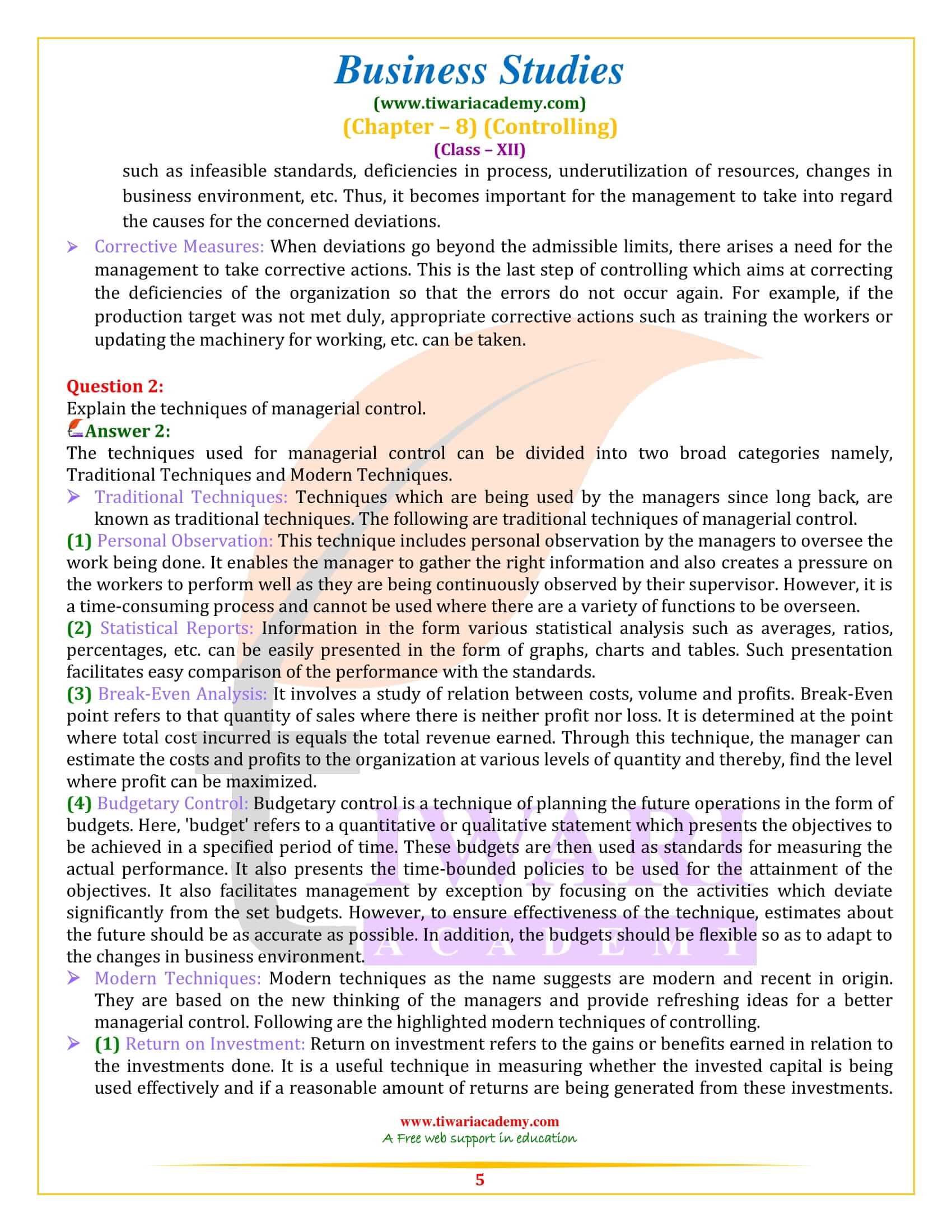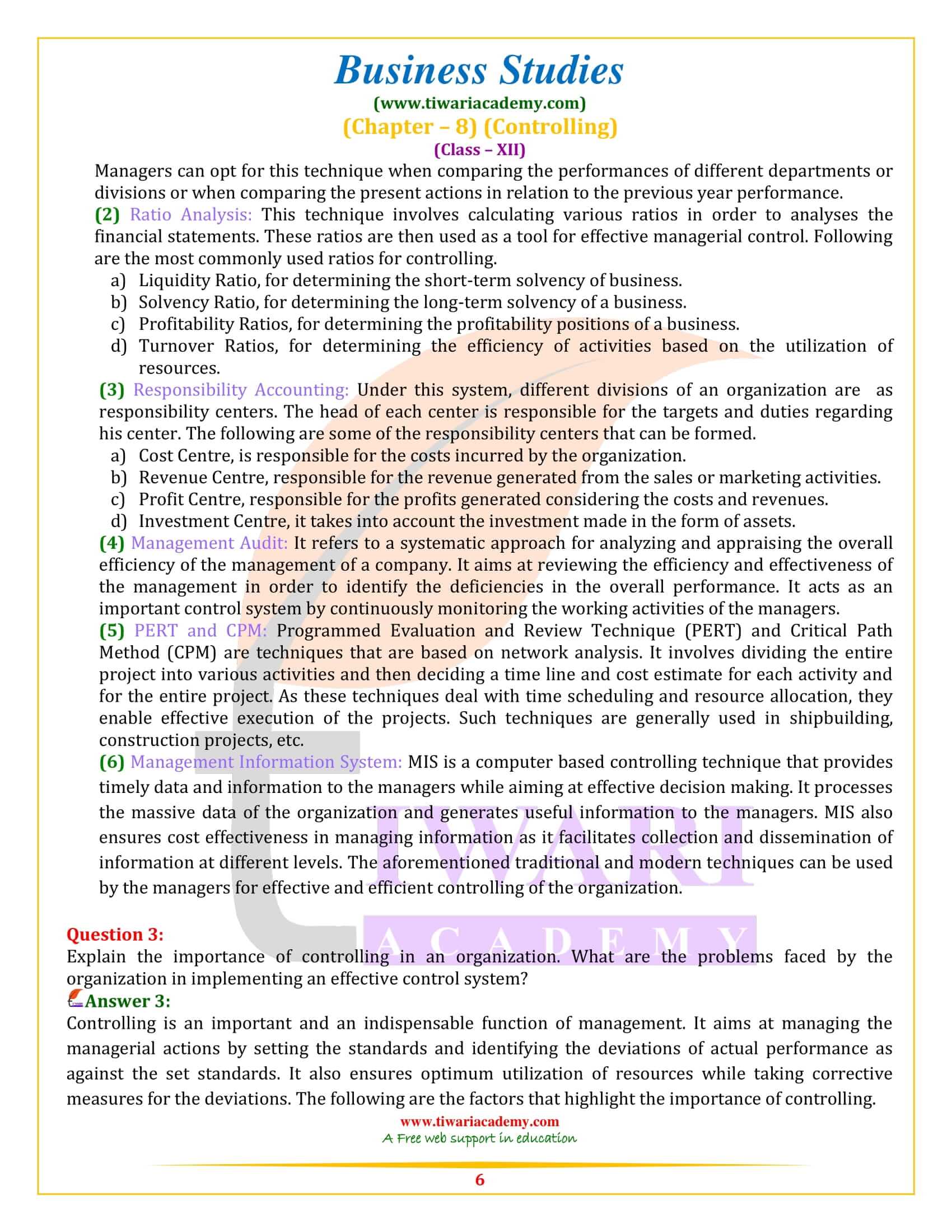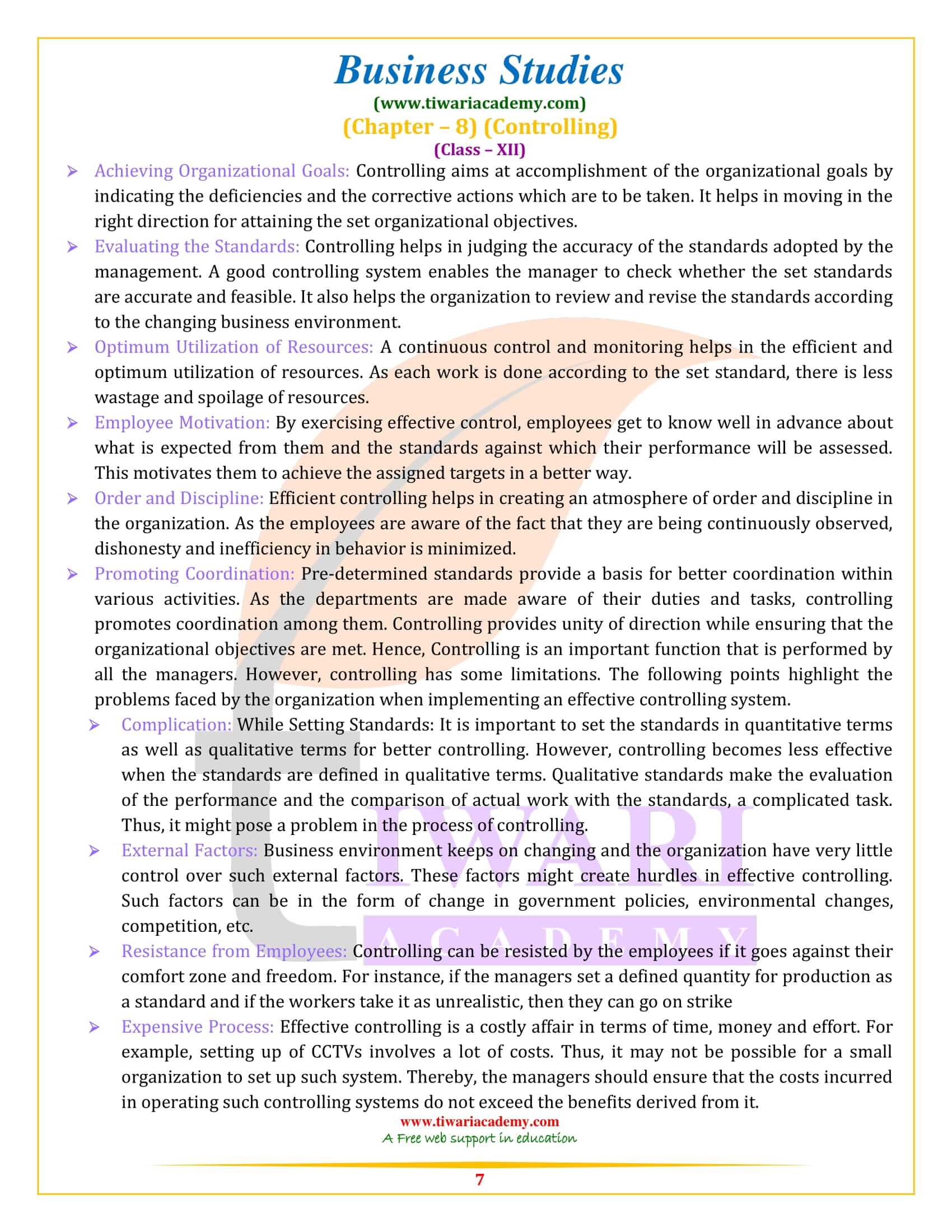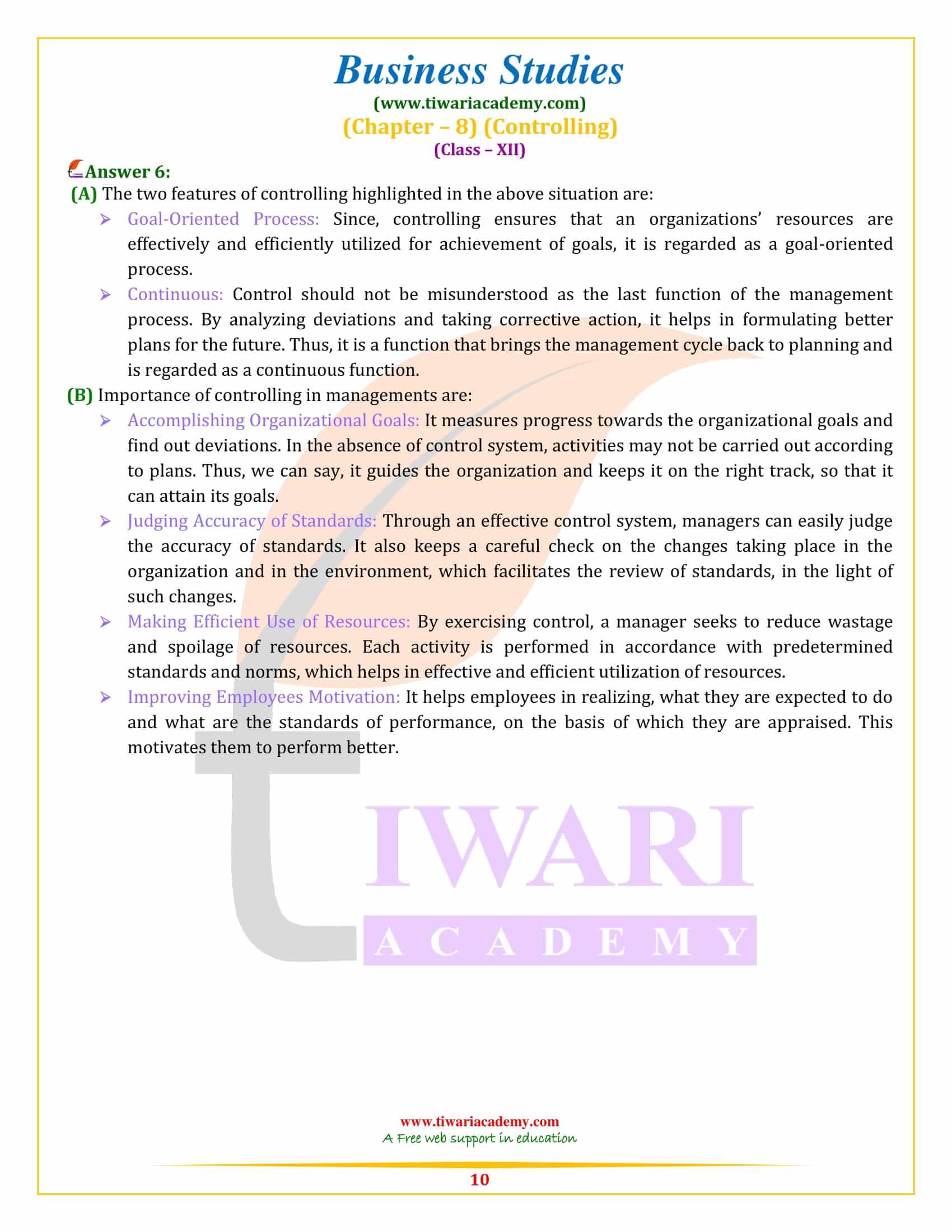NCERT Solutions for Class 12 Business Studies Chapter 8 Controlling updated for new academic session 2025-26. Class 12 B St Solutions for chapter 8 are given in simplified format with MCQ, so that every child can understand it easily.
Viva Voice for Class 12 B St
NCERT Solutions for Class 12 Business Studies Chapter 8
Class 12 Business Studies Chapter 8 NCERT Solutions
Very Short Answer Type Questions
State the meaning of controlling.
Controlling refers to the function of evaluating and assessing the progress of the work done. It involves setting a specific criteria or standards for the work and then comparing the actual work with the set standards. It helps in finding the deviations from the set targets and thereby, take the required corrective actions. It ensures that everything goes as per the plans adopted. It also ensures full and efficient utilization of resources. Controlling is an imperative managerial function as it keeps a close check on the progress of work and thereby, forms the basis for future actions and planning.
Name the principle that a manager should consider while dealing with deviations effectively. State any one situation in which an organizations’ control system loses its effectiveness.
The principle that a manager should considered while dealing with deviations effectively is management by exception.
State any one situation in which an organizations’ control system loses is effectiveness.
An organizations’ control system loses its effectiveness when standards are to be defined in qualitative terms. Standard defined in qualitative terms make measurement of performance and their comparison with standards difficult.
Give any two standards that can be used by a company to evaluate the performance of its Finance & Accounting department.
The two standards that can be used by a company to evaluate the performance of its Finance and Accounting department are Capital expenditure and inventories.
Which term is used to indicate the difference between standard performance and actual performance?
The term that is used to indicate the difference between standard performance and actual performance is the deviation.
Short Answer Type Questions
Planning is looking ahead and controlling is looking back. Comment.
Planning is looking ahead and controlling is looking back. This statement is partially true. Planning is a psychological process of ‘thinking and deciding in advance’ about ‘what is to be done’ and ‘how it is to be done’. It is a mental activity that includes deciding the goals and also the actions through which they are to be accomplished. Thus, it is said that planning is looking ahead as it involves predicting the future.
Controlling on the other hand, involves an assessment of the past performance and evaluating them against the set standards. In this sense, controlling is said to be a backward-looking function. However, both these statements are only partially true. Though planning is a futuristic concept but it is based on past actions and experiences.
Planning for future cannot take place without peeping into the past. Similarly, though controlling involves assessment of past performance, it also aims at improving the future performance by taking the required corrective actions. Hence, we can say that planning and controlling are backward looking as well as forward looking functions.
An effort to control everything may end up in controlling nothing. Explain.
The statement, ‘an effort to control everything may end up in controlling nothing’ is in regard with the principle of ‘Management by Exception’. It stresses on the fact that everything cannot be effectively controlled. According to this principle, rather than controlling each and every deviation in performance, an acceptable limit of deviations in various activities should be set and only those deviations that go beyond the acceptable range should be brought to the notice of the managers for control. In other words, only the major deviations which are beyond permissible limit should be acknowledged. For instance, suppose the acceptable range of increase in the input cost is set at 3 percent. In this case, only a more than 3% increase in the input cost (say 7%) should be brought to the notice of the managers. On the other hand, a less than 3% increase (say 1%) should be neglected. Hence, an effort should be there to control only the major things instead of trying to control everything.
Write a short note on budgetary control as a technique of managerial control.
Budgetary control is a technique of controlling that involves preparing plans in the form of budgets. Budget refers to a financial or a quantitative statement that defines the targets to be achieved and the policies to be followed in a specific period of time. The actual performance is then compared with the budgetary standards. This comparison helps in identifying the deviations and thereby, guides in taking appropriate corrective measures. Budget can be prepared for different divisions of the organization such as sales budget, production budget, purchase budget, etc. However, for the budgeting to be effective, future estimates must be made carefully. Budgeting also acts as a source of motivation for the employees by setting the standards against which their performance will be assessed. Thus, it encourages them to achieve the set objectives. In addition, it is also used to facilitate coordination among different divisions/departments of the organization. Moreover, proper budgeting ensures that resources are allocated to different divisions as per their requirements. Thereby, it helps in optimum utilization of the resources.
Explain how management audit serves as an effective technique of controlling.
Management audit refers to the extensive and constructive appraisal of the overall performance of the management of an organization. It aims at improving the overall effectiveness and efficiency of the management. It evaluates all the functions performed by the managers and helps in identifying the deficiencies in the work performance. The effectiveness of management audit for controlling can be judged from the following points:
- Identification of Deficiencies: Management audit helps in recognizing the current as well as probable deficiencies in the performances. Thereby, it helps in taking the necessary corrective measures.
- Improves Efficiency: Through management audit, various activities of the management can be continuously monitored. Thereby, it helps in improving the overall efficiency of the management.
- Enhances Coordination: It improves the coordination between employees as well as within the different functions of the organization as it continuously oversees the work.
- Adapting to Environmental Changes: It helps the organization to adapt to the environmental changes appropriately. This is done by ensuring that the managerial policies and strategies are up-to-date.
Mr. Arfaaz had been heading the production department of Write well Products Ltd., a firm manufacturing stationary items. The firm secured an export order that had to be completed on a priority basis and production targets were defined for all the employees. One of the workers, Mr. Bhanu Prasad, fell short of his daily production target by 10 units for two days consecutively. Mr. Arfaaz approached Ms. Vasundhara, the CEO of the Company, to file a complaint against Mr. Bhanu Prasad and requested her to terminate his services. Explain the principle of management control that Ms. Vasundhara should consider while taking her decision. (Hint: Management by exception).
The principle of management control that Ms. Vasundhara should consider while taking her decision is management by exception. It means if a manager tries to control everything, he may end up by controlling nothing. To make control effective and economical, it must focus attention on factors critical to performance. Therefore the manager should pay serious attention to only such cases, which are critical to success. In the above case Mr. Bhanu Prasad, fell short of his daily production target by only 10 units. This is very small deviation and it is not right to terminate him on the basis of this small deviation.
Long Answer Type Questions
Explain the various steps involved in the process of control.
Controlling is a systematic approach of managing and controlling the organizational actions. The following are the steps involved in the controlling process.
Setting Standards: Setting up of standards involves developing the benchmarks against which the actual performance is to be measured. The standards can be set in qualitative as well as quantitative terms. Qualitative benchmarks can be in the form of improving coordination in work, higher goodwill or increased motivation level of employees, etc. For example, to improve the motivation level among employees, standard can be set in terms of number of initiatives taken. Quantitative benchmarks can be in the form of sales targets, units to be produced or time to be spent on a particular action, etc. For example, in a shirt factory completing 10 pieces a day is a quantitative target. The standards that are set should be such that they facilitate easy comparison.
Measuring Actual Performance: Once the standards are set, the next step is to measure the actual performance of the activities. This may be done through various techniques such as personal observation, checking the sample, performance reports, etc. The checking should be done in an exact and reliable manner so that correct measurement is taken for comparison. Measurement can be done after the completion of an activity as well as while it is in progress. For example, while assembling small parts of a bigger machine, the parts can be checked before assembling. This would ensure the continuous monitoring of the small parts as well as the final machine.
Comparing the Performances: Performances once measured are then compared with the set standards. Such a comparison helps in assessing the deviations in the work. Thereby, it guides the managers in taking the necessary steps so as to improve the performances. These comparisons are easier when they are in quantitative terms. For example, efficiency in work in terms of cost incurred can be measured against the standard cost.
Analyzing Deviation: Every organization faces deviations when comparing the actual performance with the redeveloped standards. Thus, it is important to find the deviations that are in the permissible range. It is said that deviations in key areas should be attended first. For analyzing the deviations the managers generally use ‘Critical Point Control’ and ‘Management by Exception’
1. Critical Point Control: An organization cannot keep a check on all the activities of the management. Thus, this technique of controlling aims at focusing on only the key result areas (KRAs) that affect the entire organization. For example, rise in input cost would be more important than rise in stationary cost.
2. Management by Exception: This technique of management is based on the belief that ‘an attempt to control everything results in controlling nothing’. According to this, only the essential and significant deviations that are beyond the acceptable limit should be controlled. For example, if there is a 6 per cent rise in labor cost whereas the permissible limit is just 3 per cent, then, this should be immediately brought into the notice of the management. On the other hand, a 2 percent rise in the cost can be ignored. Once the deviations are recognized, it is necessary to acknowledge the cause for it. There can be a number of elements causing deviations in work such as infeasible standards, deficiencies in process, underutilization of resources, changes in business environment, etc. Thus, it becomes important for the management to take into regard the causes for the concerned deviations.
Corrective Measures: When deviations go beyond the admissible limits, there arises a need for the management to take corrective actions. This is the last step of controlling which aims at correcting the deficiencies of the organization so that the errors do not occur again. For example, if the production target was not met duly, appropriate corrective actions such as training the workers or updating the machinery for working, etc. can be taken.
Explain the techniques of managerial control.
The techniques used for managerial control can be divided into two broad categories namely, Traditional Techniques and Modern Techniques.
Traditional Techniques: Techniques which are being used by the managers since long back, are known as traditional techniques. The following are traditional techniques of managerial control.
(1) Personal Observation: This technique includes personal observation by the managers to oversee the work being done. It enables the manager to gather the right information and also creates a pressure on the workers to perform well as they are being continuously observed by their supervisor. However, it is a time-consuming process and cannot be used where there are a variety of functions to be overseen.
(2) Statistical Reports: Information in the form various statistical analysis such as averages, ratios, percentages, etc. can be easily presented in the form of graphs, charts and tables. Such presentation facilitates easy comparison of the performance with the standards.
(3) Break-Even Analysis: It involves a study of relation between costs, volume and profits. Break-Even point refers to that quantity of sales where there is neither profit nor loss. It is determined at the point where total cost incurred is equals the total revenue earned. Through this technique, the manager can estimate the costs and profits to the organization at various levels of quantity and thereby, find the level where profit can be maximized.
(4) Budgetary Control: Budgetary control is a technique of planning the future operations in the form of budgets. Here, ‘budget’ refers to a quantitative or qualitative statement which presents the objectives to be achieved in a specified period of time. These budgets are then used as standards for measuring the actual performance. It also presents the time-bounded policies to be used for the attainment of the objectives. It also facilitates management by exception by focusing on the activities which deviate significantly from the set budgets. However, to ensure effectiveness of the technique, estimates about the future should be as accurate as possible. In addition, the budgets should be flexible so as to adapt to the changes in business environment.
Modern Techniques: Modern techniques as the name suggests are modern and recent in origin. They are based on the new thinking of the managers and provide refreshing ideas for a better managerial control. Following are the highlighted modern techniques of controlling.
(1) Return on Investment: Return on investment refers to the gains or benefits earned in relation to the investments done. It is a useful technique in measuring whether the invested capital is being used effectively and if a reasonable amount of returns are being generated from these investments. Managers can opt for this technique when comparing the performances of different departments or divisions or when comparing the present actions in relation to the previous year performance.
(2) Ratio Analysis: This technique involves calculating various ratios in order to analyses the financial statements. These ratios are then used as a tool for effective managerial control. Following are the most commonly used ratios for controlling.
a) Liquidity Ratio, for determining the short-term solvency of business.
b) Solvency Ratio, for determining the long-term solvency of a business.
c) Profitability Ratios, for determining the profitability positions of a business.
d) Turnover Ratios, for determining the efficiency of activities based on the utilization of resources.
(3) Responsibility Accounting: Under this system, different divisions of an organization are as responsibility centers. The head of each center is responsible for the targets and duties regarding his center. The following are some of the responsibility centers that can be formed.
a) Cost Centre, is responsible for the costs incurred by the organization.
b) Revenue Centre, responsible for the revenue generated from the sales or marketing activities.
c) Profit Centre, responsible for the profits generated considering the costs and revenues.
d) Investment Centre, it takes into account the investment made in the form of assets.
(4) Management Audit: It refers to a systematic approach for analyzing and appraising the overall efficiency of the management of a company. It aims at reviewing the efficiency and effectiveness of the management in order to identify the deficiencies in the overall performance. It acts as an important control system by continuously monitoring the working activities of the managers.
(5) PERT and CPM: Programmed Evaluation and Review Technique (PERT) and Critical Path Method (CPM) are techniques that are based on network analysis. It involves dividing the entire project into various activities and then deciding a time line and cost estimate for each activity and for the entire project. As these techniques deal with time scheduling and resource allocation, they enable effective execution of the projects. Such techniques are generally used in shipbuilding, construction projects, etc.
(6) Management Information System: MIS is a computer based controlling technique that provides timely data and information to the managers while aiming at effective decision making. It processes the massive data of the organization and generates useful information to the managers. MIS also ensures cost effectiveness in managing information as it facilitates collection and dissemination of information at different levels. The aforementioned traditional and modern techniques can be used by the managers for effective and efficient controlling of the organization.
FAQs
In what sense the term controlling is used in chapter 8 of 12th B. St.?
Controlling means finding out the deviation between standard performance and actual performance and taking corrective action.
What are the important questions from chapter 8 of 12th B. St.?
Perhaps, The most important question is the interrelationship of planning and controlling.
What should the student remember while studying chapter 8 of 12th Business Studies?
Planning and control are both forward looking and backward looking also. For details please refer to Tiwari Academy notes on the subject.
What are peculiar points to remember in chapter 8 of Class 12 Business Studies?
The techniques of controlling like management audit, PERT and CPM etc. are basically subject taught in senior classes. From examination point of view the steps, importance and limitations of controlling are important.


